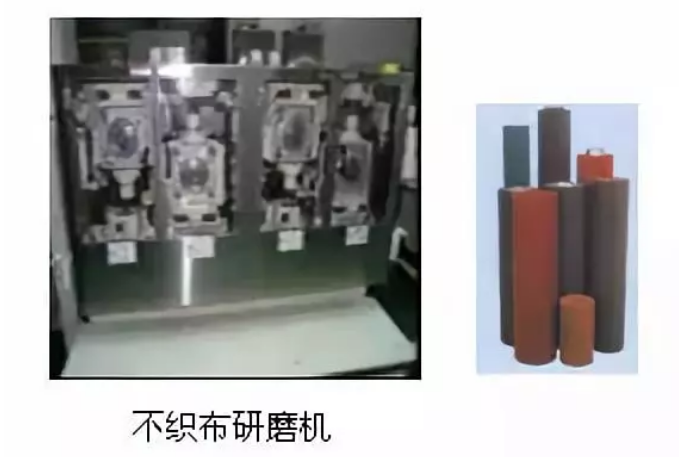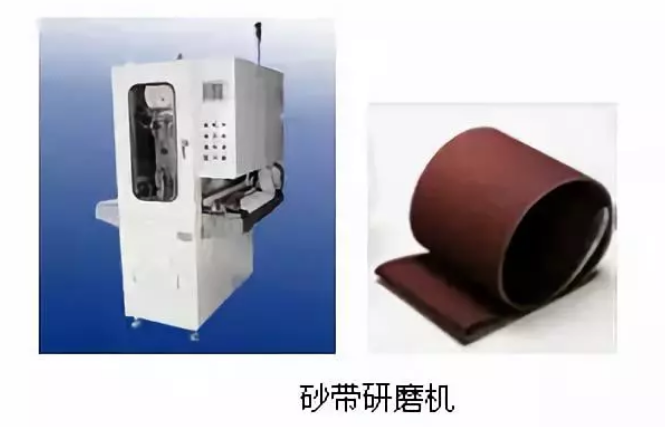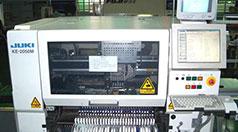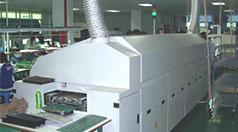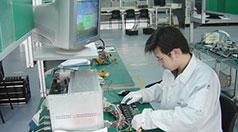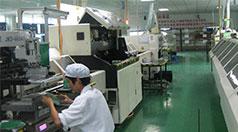What are the production process of resin plugging technology?
For POFV products (the process of the factory is different)
1. Cutting material → drilling → PTH / plating → plug hole → baking → grinding → PTH / plating → outer layer → anti-welding → surface treatment → forming → electric test → FQC → shipment
2. Cutting material → drilling → sinking copper → plate electricity → plate electricity (thick copper) → resin plug hole → grinding → drill through hole → sink copper → plate electricity → outer layer → graphic plating → etching → resistance welding → Surface treatment → molding → electric measurement → FQC → shipment
For inner layer HDI resin plugging products
Grinding process:
1. Cutting material → buried hole inner layer pattern → AOI →pressing → drilling → PTH / plating → plug hole → baking → grinding → inner layer line → browning → pressing → drilling (laser drilling / mechanical drilling) →PTH/Electroplating→Outer circuit → Anti-weld → surface treatment → Formation → Electrical measurement → FQC → shipment
2, the material → buried hole inner layer graphics → AOI → pressure → drilling → sink copper → plate electricity → plate electricity (thick copper) → resin plug hole → polished → inner layer graphics → AOI → pressure → drill through hole → sink copper → plate electricity → outer layer graphics → graphics plating → etching → resistance welding → surface treatment → molding → electric measurement → FQC → shipment
No grind process
open material → buried hole inner layer pattern → AOI → press → drilling → PTH / plating → inner layer line → browning → plug hole → flattening → baking → pressing → drilling (laser drilling / machinery Drilling)→PTH/electroplating→outer circuit→resistive welding → surface treatment → forming → electric measurement → FQC → shipment
For outer layer resin plugging Products
1. Cutting material → drilling → PTH / plating → plug hole → baking → grinding → baking → outer layer line → anti-welding → surface treatment →forming →electric test → FQC → shipment
2.Cutting material → drilling → sinking copper → plate electricity → plate electricity (thick copper) → resin plug hole → baking → grinding → baking → outer layer → graphic plating → etching → resistance welding → surface treatment → forming → electric test → FQC → shipment
What are the special places in the process?
From the above process, we clearly found that the process is different. Generally speaking, our understanding is that the “resin plug hole” is followed by the “drilling through hole and copper sink” process, which we all consider to be POFV products; if the “resin plug hole” is followed by the “process” "Layer pattern", we think it is the inner layer HDI resin plug product; if the "resin plug hole" is followed by the "outer pattern";
The above different types of products are strictly defined in the process, can not go wrong; Keding Chemical developed three different inks for the characteristics of the above three processes, TP-2900S\TP-2900\TP-2900C These three inks correspond to the above three processes.
How can we improve the process?
A. For products with resin plug holes, in order to improve the quality of the products, people are constantly adjusting the process to simplify his production process and improve the yield of his production;
B. Especially for the product of the inner layer HDI plug hole, in order to reduce the scrap rate of the inner layer open circuit after grinding, people adopt the process of re-plugging the hole after the circuit is made, first complete the inner layer circuit production, after the resin plug hole The resin is pre-cured and then cured at a high temperature in the press-bonding stage.
C. At the beginning, for the inner layer HDI plug hole, people use UV pre-solid + thermosetting ink. At present, more often use thermosetting resin, which effectively improves the inner layer HDI resin. Thermal performance of the plug hole.
What is the resin plugging process?
Ink used in resin plug hole
A. There are many types of inks currently used in the resin plugging process on the market. Commonly used are the brands of suppliers such as San-Ei and Kotti.
Process conditions for resin plug hole
A. There are tens of thousands of holes in the resin plug hole, and it is guaranteed that one hole cannot be full. This one-tenth of the defects will lead to the possibility of scrapping, and it will inevitably require rigorous thinking and regulation in the process.
B. Good plugging equipment is an inevitable requirement. Screen printing machines currently used for resin plug holes can be divided into two categories, vacuum plugging machines and non-vacuum plugging machines.
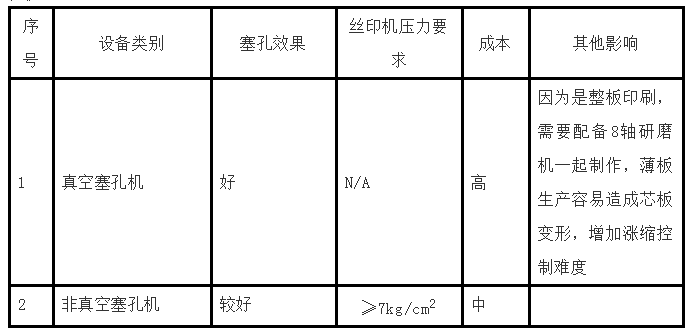
legend:
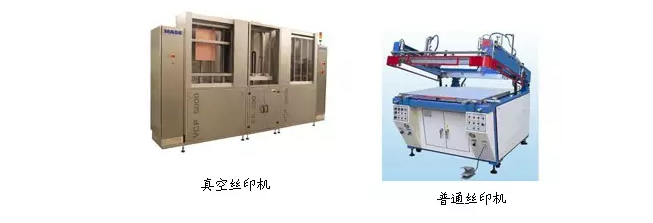
Common screen printing machine plugging process
A. The choice of screen printing machine is important to consider the maximum cylinder pressure, lifting method, smoothness and levelness of the tool holder;
B, screen printing scraper needs to use 2CM thickness, 70-80 degree hardness of the scraper, of course, must have the characteristics of strong acid and alkali resistance;
C. Screen printing screen selection can choose wire mesh or aluminum film; what is to be controlled is to select the appropriate mesh mesh number and the window opening size for the aperture according to the requirements of the plug hole process conditions;
D. The pad used for the resin plug hole has a variety of exquisite, but it is often ignored by engineers. The pad not only acts as a gas guide, but also plays a supporting role. For the dense hole area, after the pad is drilled, the whole area is empty. In this position, the pad is bowed or deformed, and the support force to the plate is the worst, which will cause the hole to be inserted at the position. The fullness is very poor. Therefore, when making the pad, to find a way to overcome the problem of large-area vacancies, the best practice at present is to use a 2mm thick pad, only 2/3 of the depth of the pad.
E. In the printing process, the most important thing is to control the pressure and speed of printing. Generally speaking, the larger the aspect ratio, the smaller the aperture, the slower the required speed and the greater the pressure requirement. Controlling slower speeds works best for the improvement of plug holes.
Plugging process of vacuum resin plugging machine
Due to the high price of vacuum resin plugging machines and the confidentiality of their equipment use and maintenance technology, there are only a handful of PCB manufacturers that can use this technology.
The plugging technology of the VCP vacuum resin plugging machine mainly has an ink clip and two plugs that can be traversed, and there are many small holes in the plug head. After the device has pumped the vacuum, the ink in the ink clip is pushed by the piston to the small hole in the plug hole. The two traversing plug holes first clamp the plate, and then fill the ink through many small holes in the plug hole. Through holes or blind holes in the board. The board is hung vertically in the vacuum chamber, and the traversing plug head can be moved down until the hole in the board is filled with resin. The plug head and ink pressure can be adjusted to meet the plug hole fullness. Different board sizes can be used to plug holes with different size plug heads. After the plug hole is completed, it can be scraped off with a doctor blade plug ink and then added to the plug hole ink clip for reuse.
At present, there is also a type of vacuum plugging machine which performs printing by means of a screen, and uses a CCD alignment system to align, and its operation is similar to ordinary silk screen printing, but an additional vacuum plug hole flow. This type of plug hole has the best effect, but it has not been widely used due to expensive equipment investment.
The use of a vacuum plug machine is undoubtedly the best way to solve the bubble problem of the resin, and the selection of the plug ink is basically not limited by the process. However, because the entire surface has a resin, it causes great difficulty in removing the resin. Need to be used together with a good sander.
Polishing after resin plugging
A. Non-woven cloth grinding machine or belt grinding machine is an indispensable equipment for making resin plug holes. On the one hand, it is required that the equipment should be able to effectively remove the resin on the surface of the board. On the other hand, the roughness of the copper surface is not required. Wipe the flowers, scratches and other issues.
